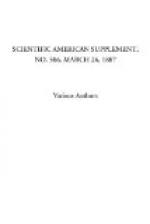In spite of its fragile appearance this viaduct has, up to the present time, served in a most satisfactory manner the purpose for which it was built.—Engineering.
* * * * *
SEA-GOING TORPEDO BOATS.
All investigations of the sea-going qualities of torpedo boats show that while the basin experiments are highly satisfactory, those made at sea prove with equal force the unreliability of these craft when they leave the coast. At the beginning of the Milford Haven operations, the boisterous weather necessitated the postponing of operations, on account of the unfitness of the torpedo boat crews to continue work after the twelve hours of serious fatigue they had already undergone. In the French evolutions, the difficulties of the passage from Bastia to Ajaccio, although not remarkably severe, so unfitted fifteen of the twenty boats that they could take no part in the final attack. In two nights we find recorded collisions which disable boats Nos. 52, 61, 63, and 72, and required their return to port for repairs.
Of the twenty-two torpedo boats leaving Toulon a few days before, but six arrived near the enemy, although their commanders displayed admirable energy. One had run aground, and was full of water; another had been sunk by collision; another’s engine was seriously injured; and as for the rest, they could not follow.
Of the boats under the command of Admiral Brown de Colstoun, but five remained for service, for the sixth received an accident to her machinery which prevented her taking part in the attack.
During the operations off the Balearic Isles, only one of six boats attacked, and none was able to follow the armorclads, all meeting with circumstances quite unexpected and embarrassing.
With the weather as it existed May 13, the armorclads had the torpedo fleet completely at their mercy, for even if they had not been destroyed by the excellent practice of the Hotchkiss gunners, they would have been of no use, as they could not with safety discharge their torpedoes. In fact, the search lights discovered distinctly that one of the boats, which burned her Coston’s signal to announce victory, did not have her torpedo tube open, on account of the heavy sea.
Furthermore, their positions were frequently easily discovered by the immense volume of smoke and flame ejected while going at great speed. This applies as well by night as by day. It was also reported that after the four days’ running the speed of the boats was reduced to twelve knots.
With such evidence before us, the seaworthiness of boats of the Nos. 63 and 64 type may be seriously questioned. Weyl emphasizes the facts that “practice has shown that boats of No. 61 type cannot make headway in a heavy sea, and that it is then often impossible to open their torpedo tubes. On this account they are greatly inferior to ships of moderate tonnage, which can certainly make some progress, fire their torpedoes, and use their artillery in weather when a torpedo boat will be utterly helpless. The torpedo boat abandoned to itself has a very limited field of action.”




